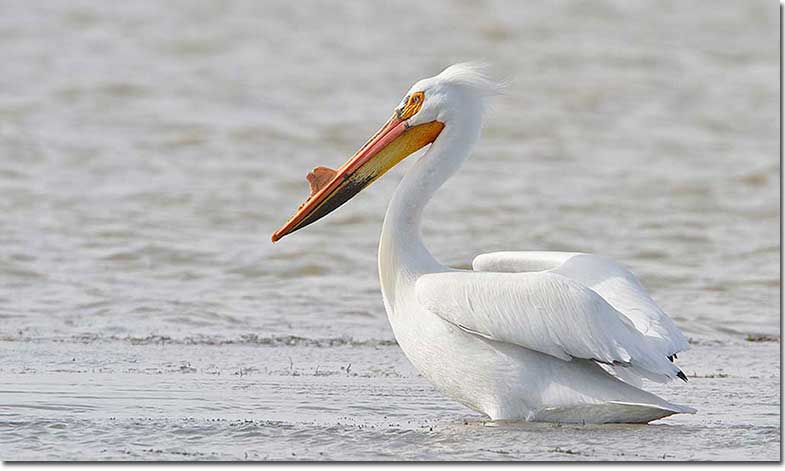
Very Small | Small | Medium | BIGGEST BIRDS
It is quite well-known that the largest bird in the world is the Common Ostrich.
But did you know that there are many other large birds that are worth exploring?
From flightless birds like emus to soaring birds of prey like vultures, the avian world is full of impressive giants.
In this article, we will take a closer look at some of the biggest birds on Earth, their unique characteristics, and the habitats they call home.
On this page
- Ostriches, Emus, Rheas – Family Ratite
- Ducks, Geese and Swans – Family Anatidae
- Partridges, Grouse, Turkeys – Family Phasianidae
- Pelicans – Family Pelecanidae
- Herons, Egrets and Bitterns – Family Ardeidae
- New World Vultures – Family Cathartidae
- Cranes – Family Gruidae
- Ducks, Geese and Swans – Family Anatidae
- Loons – Family Gaviidae
- Herons, Egrets and Bitterns – Family Ardeidae
- Ibis, Spoonbills – Family Threskiornithidae
- Hawks, Kites, Eagles – Family Accipitridae
- Gulls, Terns, and Skimmers – Family Laridae
- Owls – Family Strigidae
- Frequently Asked Questions
Ostriches, Emus, Rheas – Family Ratite
Ratites are a group of birds characterized by their large size, long necks, and legs, and their inability to fly. The only exceptions are kiwis, much smaller and shorter of these species.
Common Ostrich
Struthio camelus
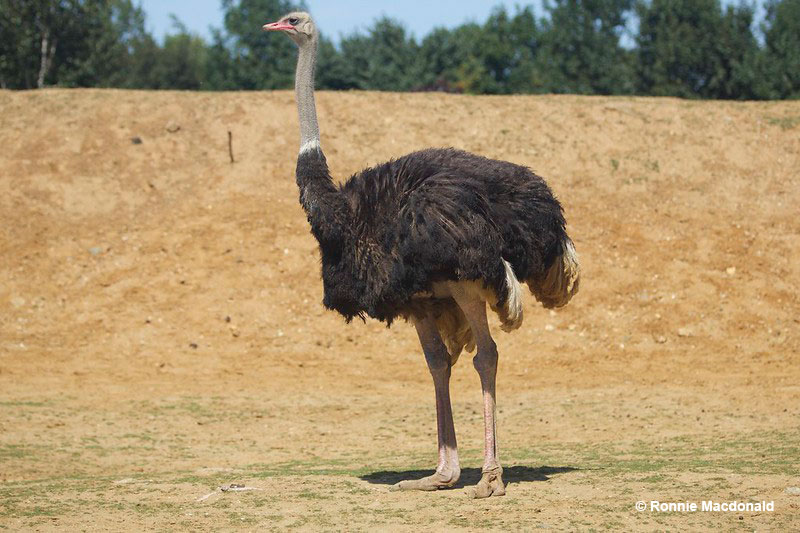
Common Ostrich – 8 feet © Ronnie Macdonald
- Average size: 5 ft 9 in – 9 ft (1.75-2.75 m)
- Average weight: 200-290 pounds (90-120 kg)
The Common Ostrich, the largest living bird, is a flightless species limited to drier and sandy regions in central and southern Africa. They’re easily identifiable by their long neck and legs. Adult males have mostly black feathers with white primaries and a white tail. On the other hand, females and young males are grayish-brown and white.
When threatened, they have two options; either hide by lying flat against the ground or run away.
They are impressive runners, capable of running for a long time at a speed of 34 mph. If needed, they can run faster in short bursts of speed up to 40 mph, making them the fastest birds on land. If cornered, they can defend themselves with a powerful kick from their legs.
Emu
Dromaius novaehollandiae
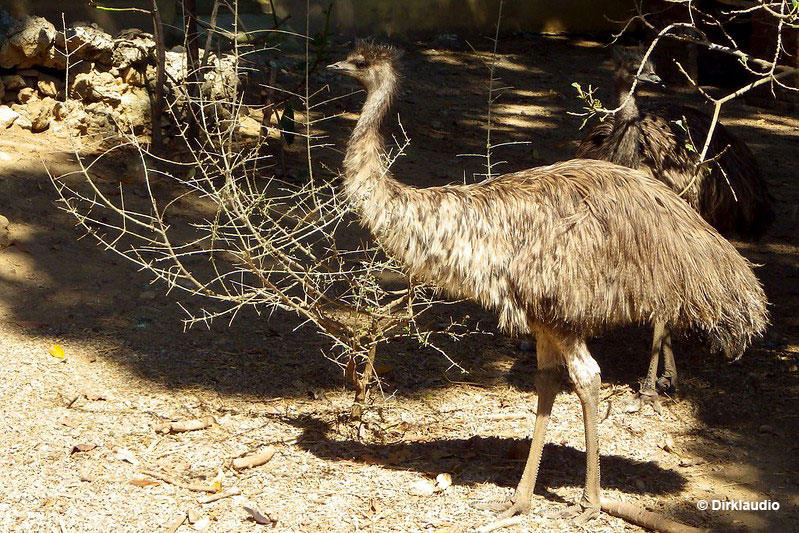
Emu – 5-6 feet © Dirklaudio
- Average size: 4 ft 7 in – 6 ft 3 in (1.4-1.9 m)
- Average weight: 40-132 pounds (18-60 kg)
The Emu, the second-tallest living bird species, is exclusively found in mainland Australia and inhabits nearly the entire continent, except for heavily wooded areas and desert regions. These brown, flightless birds with long necks and legs are soft-feathered and have a shaggy plumage of dark brown feathers.
Their plumage can vary based on the environment, often reflecting the general color of their surroundings.
While generally solitary birds, Emus exhibit social behaviors whenever advantageous. They are capable of traveling great distances and can sprint at 30 mph when necessary. Their diet includes plants and insects. When needed, they can go for weeks without eating and also drink infrequently, but when they find food and water, they gulp down as much as they can.
Greater Rhea
Rhea americana
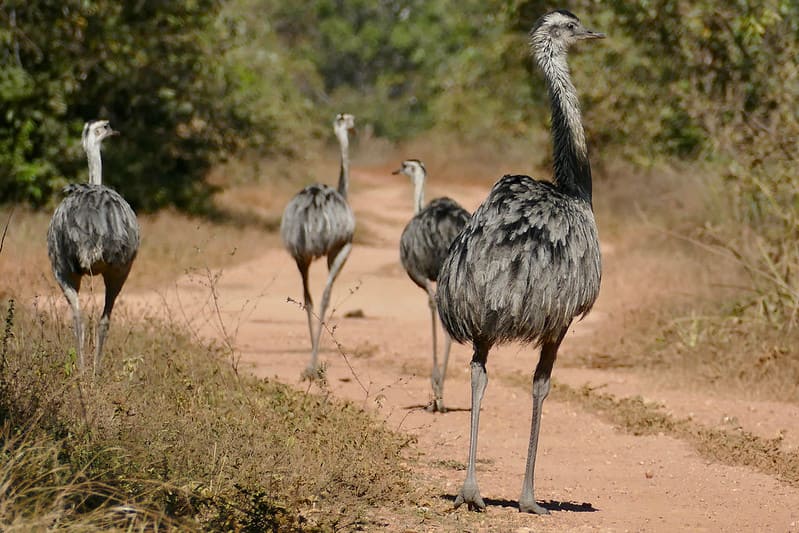
Greater Rhea © Bernard Dupont (Flickr)
- Average size: 3-5 feet (0.9-1.5 m)
- Average weight: 44-60 pounds (20-27 kg)
The Greater Rhea is another flightless bird species that is native to a variety of open areas in southeastern South America. It is the largest bird species in the Americas. They have long protruding necks and fluffy tattered-looking plumage in shades of gray or brown. The head, neck, rump, and thighs are feathered, and males are generally darker than females.
During the non-breeding season, the Greater Rhea forms flocks of 10 to 100 birds and typically remains silent. The flocks disband at the beginning of the breeding season and the birds start producing low booming noises. If chased, they have a unique fleeing behavior, characterized by a zigzag pattern where they alternately raise one wing and then the other.
Regardless of their rather large geographic range, this species is listed as near threatened on the IUCN Red List due to a rapidly declining population caused by hunting and habitat conversion.
Ducks, Geese and Swans – Family Anatidae
Waterfowl in the Anatidae family, such as ducks, geese, and swans, have evolved to swim, float, and dive. They are often monogamous, migratory, and herbivorous. The family consists of 174 species in 43 genera which are widespread across all continents except Antarctica.
Trumpeter Swan
Cygnus buccinator
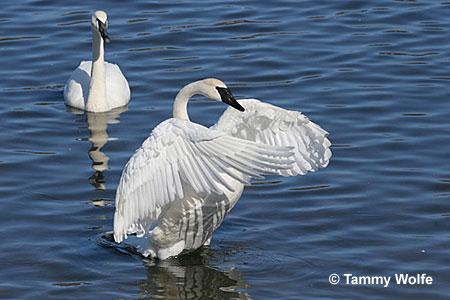
Trumpeter Swan – 5 feet
- Average size: 4ft 6 in – 5 ft 5 in (1.4-1.65 m)
- Average weight: 15-30 pounds (7-13.6 kg)
Trumpeter Swans look regal with their entirely white plumage and black bills and legs. They range throughout parts of Alaska, Canada, and the northwestern United States. You can find them in wetlands with open water and areas near rivers or streams. They live in small flocks, often consisting of family members, and have an interesting approach to incubation – they warm their eggs with their webbed feet.
They are the largest native North American waterfowl. Despite their great size, they usually still appear regal and graceful – unless they’re trying to take flight. They need a 100-yard-long runway for their rather clumsy take-off.
These swans forage underwater by up-ending themselves.
Partridges, Grouse, Turkeys – Family Phasianidae
The Phasianidae family consists of heavy ground-living birds such as partridges, junglefowl, chickens, pheasants, turkeys, peafowl, and Old World quail. Many of the 185 species are popular game birds.
Wild Turkey
Meleagris gallopavo
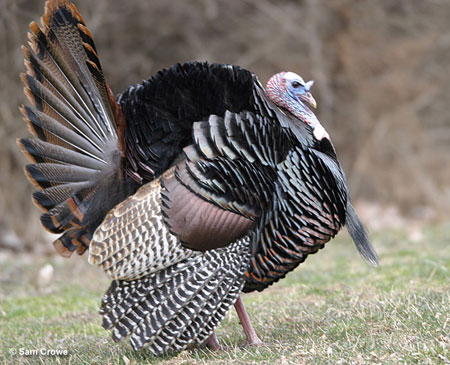
Wild Turkey – 3 feet
- Average size: 2.5-4 feet (76-125 cm)
- Average weight: 5.5-24 pounds (2.5-11 kg)
Wild Turkeys are widely distributed in the eastern and parts of the western United States. They prefer open hardwood and mixed conifer-hardwood forests. These plump birds have dark, bronze-green iridescent plumage with dark, white-barred wings and broad tails tipped with rufous or white.
Turkeys search for food in flocks on the ground and use their strong feet to scratch leaf litter. In early spring, males perform courtship displays by puffing up their feathers and giving a gobbling call. They move around by walking, running, and flying, and at night they roost in trees. Turkeys can also swim by spreading their tails, tucking their wings, and kicking.
Pelicans – Family Pelecanidae
Pelecanidae contains only one living genus consisting of 8 living pelicans. These waterbirds are characterized by predominantly white plumage, long bills, and a large throat pouch.
American White Pelican
Pelecanus erythrorhynchos
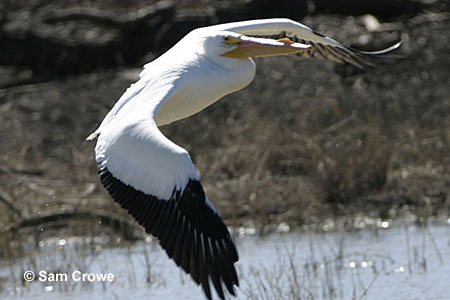
American White Pelican – 5 feet
- Average size: 4-6 feet (1.3-1.8 m)
- Average weight: 11-20 pounds (5-9 kg)
American White Pelicans are one of the longest birds native to North America. They winter in coastal and southern areas and migrate to the inland islands, wetlands, and other shallow bodies of water of the United States and Canada for the breeding season.
As their name indicates, they are almost entirely white except for the black primaries and secondaries. They have a long yellow bill with a large throat sac. During breeding season, both males and females develop a flattened protuberance on their upper bills.
These large, gregarious birds travel and forage in flocks, coordinating their swimming to drive schooling fish toward the shallows for easy scooping with their huge, flat-topped bills. On the ground, they have an awkward rolling walk, but in the air, they soar gracefully on broad, stable wings.
Herons, Egrets and Bitterns – Family Ardeidae
The Ardeidae family includes 72 carnivorous bird species that are often found near freshwater or coastal areas, such as lakes, rivers, swamps, ponds, or the sea, and are known for their long necks and legs. These medium- to large-sized birds usually stand motionless or wade slowly through shallow water while searching for prey.
Great Blue Heron
Ardea herodias
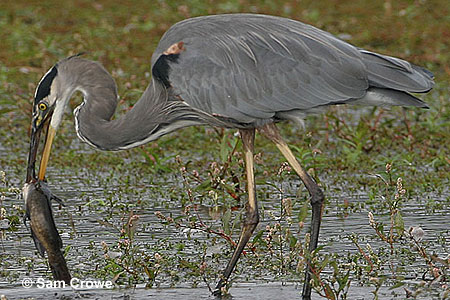
Great Blue Heron – 4 feet.
- Average size: 3-4.5 feet (91-137 cm)
- Average weight: 4-8 pounds (1.8-3.6 kg)
Great Blue Herons range throughout North and Central America and inhabit both fresh- and saltwater environments, grasslands, and agricultural fields, but typically reside in isolated swamps or near lakes and ponds surrounded by forests. You can easily recognize them by their long necks, blue-gray plumage, thick dagger-like bills, bi-colored wings, and black eye stripe that extends into head plumes.
Great Blue Herons use their patience and stealth to hunt for prey in shallow waters. They wade slowly or stand still and with a lightning-fast thrust of their long neck and sharp bill, they strike their prey with precision. As they hunt and feed, their feathers can become covered in fish slime and oils from their surroundings.
To protect their plumage, Great Blue Heron’s chest has specialized feathers that continually grow and fray. They use their fringed middle toes to comb this “powder down” and apply it to their underparts, which removes the slime and oils and protects their feathers against further contamination.
New World Vultures – Family Cathartidae
There are seven living species in the New World vulture, also known as the condor family. They’re found in temperate and warm areas in the Americas. Vultures are scavengers and mainly feed on dead animals without suffering any apparent harm.
California Condor
Gymnogyps californianus
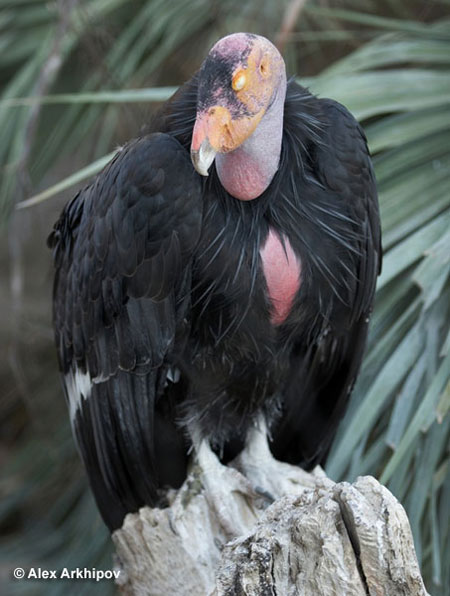
California Condor – 4 feet.
- Average size: 3.5-4.5 feet (109-140 cm)
- Average weight: 15-31 pounds (7-14 kg)
Listed as critically endangered on the IUCN Red List and once extinct in the wild until reintroduced, the California Condor is the largest North American bird. They inhabit the southern central California deserts and nest in rocky cliffs. These condors can live exceptionally long, up to 50 or more years old.
Related: Largest raptors in the world
Adults have black plumage with striking white patches under the wings and yellowish-orange naked heads. These masterful soarers rarely flap their wings while spending hours searching for carrion to feast on. They are social, form groups around different favorable feeding and roosting spots.
In 1987, only 22 California Condors had survived and were then captured. They were bred in captivity and then slowly reintroduced into the wild in 1991. The California condor conservation project is believed to be one of the most expensive species conservation projects in US history, with a cost exceeding $35 million.
Cranes – Family Gruidae
Cranes are a group of long-legged and long-necked birds that are found on most continents, excluding Antarctica and South America. They inhabit various types of wetlands, and the coloration of their plumage varies depending on their habitat.
Whooping Crane
Grus americana

Whooping Crane – 4.5 feet.
- Average size: 4-5 feet (1.25-1.6 m)
- Average weight: 10-19 pounds (4.5-8.5 kg)
The Whooping Crane is an endangered crane species known for its distinctive whooping sound that carries as far as 5 miles. Adults are white with a red crown and a long, dark, pointed bill. Despite their gradual recovery, whooping cranes remain the rarest cranes in the world, with all living individuals today being descendants of the Canada-Texas flock.
They primarily inhabit marshy areas, shallow and grassy wetlands, mudflats, and wet prairies, and prefer nesting in marshes on a raised area surrounded by water and camouflaging vegetation. Whooping Cranes tend to move slowly as they forage for food.
They typically browse and probe for their meals rather than engaging in the patient and stealthy hunting behavior exhibited by herons. When it comes to socializing, whooping cranes tend to flock in smaller groups.
Sandhill Crane
Grus canadensis
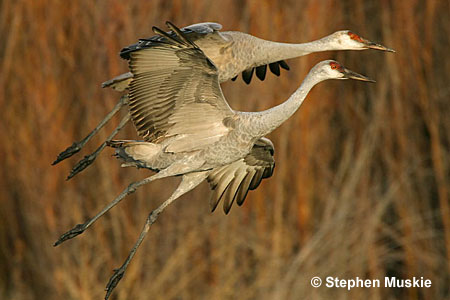
Sandhill Crane – 49 in.
- Average size: 2 ft 7 in – 4 ft 6 in (80-136 cm)
- Average weight: 6-15 pounds (2.7-6.7 kg)
Sandhill Cranes are prominent birds that can be found all over North America, recognized by their long neck, long legs, and broad wings. Their slate grey feathers are often tinged with a rusty wash on the upperparts. Adult birds have pale cheeks and red skin on their crown.
During migration and on their wintering grounds, they form massive flocks that can number in the tens of thousands, often soaring high in the sky. Breeding and foraging typically occur in open prairies, grasslands, and wetlands. Outside of the breeding season, they prefer to roost in the deeper water of ponds or lakes, where they are relatively safe from predators.
Surprisingly, Sandhill Crane chicks can leave the nest within 8 hours of hatching and are even capable of swimming.
Ducks, Geese and Swans – Family Anatidae
Ducks, geese, and swans make up the Antidae family and are adapted for swimming, floating, and diving in shallow waters.
With 174 species in 43 genera, these waterbirds reside on all continents except Antarctica and are often herbivorous, monogamous breeders, and undertake annual migrations.
Some are domesticated for agriculture, while others are hunted for food and recreation.
Snow Goose
Anser caerulescens

- Average size: 2 ft -2 ft 9 in (63-83 cm)
- Average weight: 4.5-9.9 pounds (2-4.5 kg)
The Snow Goose is a fascinating species of waterfowl that inhabits the Arctic regions of North America during the breeding season and migrates mostly to the Gulf Coast of Louisiana and Texas for winter.
There are two color morphs of the Snow Goose – the white morph, which has white plumage with black wingtips, and the blue morph, which has a dark bluish-gray plumage with a white neck, head, and tail tip.
Search for open fields and bodies of water if you want to spot Snow Geese both during the migration or in their wintering grounds across North America. These birds are hard to miss as they usually travel in large flocks, accompanied by a loud honking sound, either on the ground or in the air.
Canada Goose
Branta canadensis
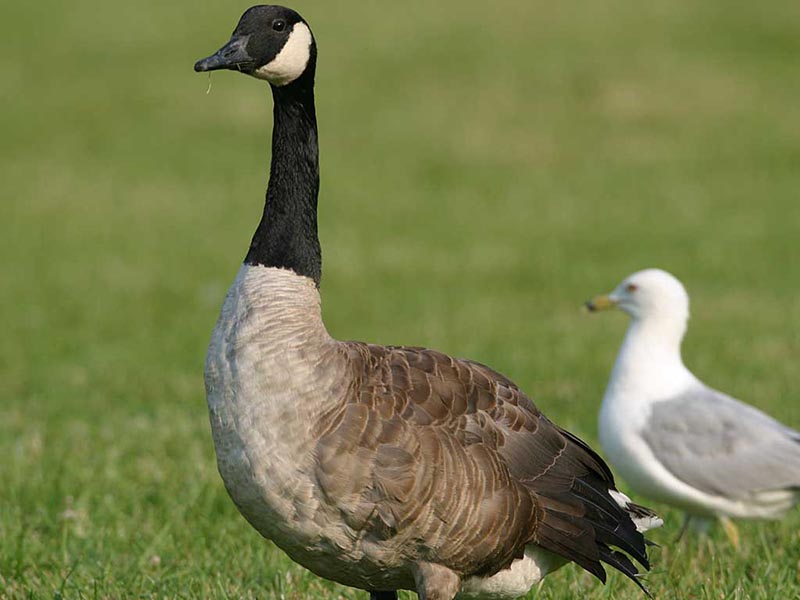
- Average size: 2 ft 6in – 3 ft 7 in (75-110 cm)
- Average weight: 5-19 pounds (2-8 kg)
Canada Geese are a common sight in North America, inhabiting open and grassy habitats from Canada down to the southern United States, and even suburban and urban areas. There are 11 subspecies of Canada Geese, with size decreasing as you move northward and coloration becoming darker as you move westward.
These large birds are bigger than Snow Geese and easily recognizable by their long black neck and distinctive white cheek patch.
Their bodies are brown with a paler chest and white underside, while their feet and legs are black.
You can easily spot them resting on the shore, swimming in open water, grazing on fields, or flying in a V-formation in the skies.
Loons – Family Gaviidae
The Gaviidae family includes the five living loon species found in North America and northern Eurasia, which are aquatic birds resembling ducks or small geese in shape.
Loons are excellent swimmers, but their feet’s position makes it difficult for them to walk on land, leading them to avoid coming to shore except for mating and nesting. They are mainly piscivorous.
Common Loon
Gavia immer
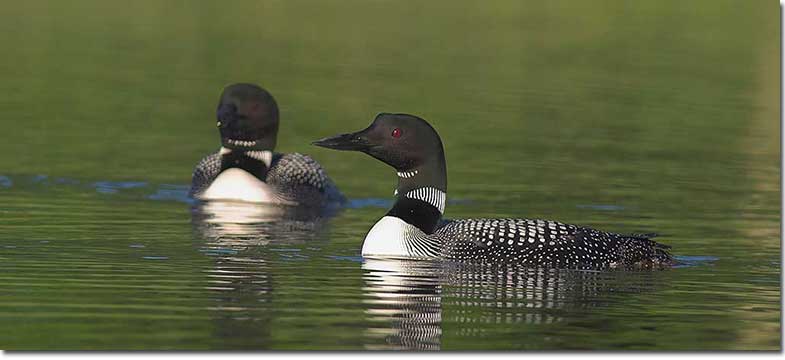
- Average size: 2 ft 2 in – 3 feet (66-91 cm)
- Average weight: 4.9-16.8 pounds (2.2-7.6 kg)
Common Loons breed in the peaceful and secluded freshwater lakes situated in the northern regions of the United States and Canada. During winter and migration periods, these birds can be found near lakes, rivers, estuaries, and coastlines.
The breeding adults exhibit a stunning regal pattern in black and white, while during the nonbreeding season, their coloration is plain gray above and white below.
During the night, Common Loon pairs and groups communicate through their distinctive eerie and beautiful calls.
These birds are adept at diving and catching fish without making a splash. They are less buoyant than most birds, and they can rapidly expel air from their lungs and flatten their feathers to swim and dive swiftly. Once submerged, the loon’s heart rate lowers to conserve oxygen.
Herons, Egrets and Bitterns – Family Ardeidae
The Ardeidae family consists of 72 medium- to large-sized freshwater and coastal bird species that have long necks and legs.
Almost all of them are associated with water and are often found near lakes, rivers, swamps, ponds, or the sea. They’re carnivorous and mostly stand motionless or wade slowly through shallow water.
Great Egret
Adrea alba
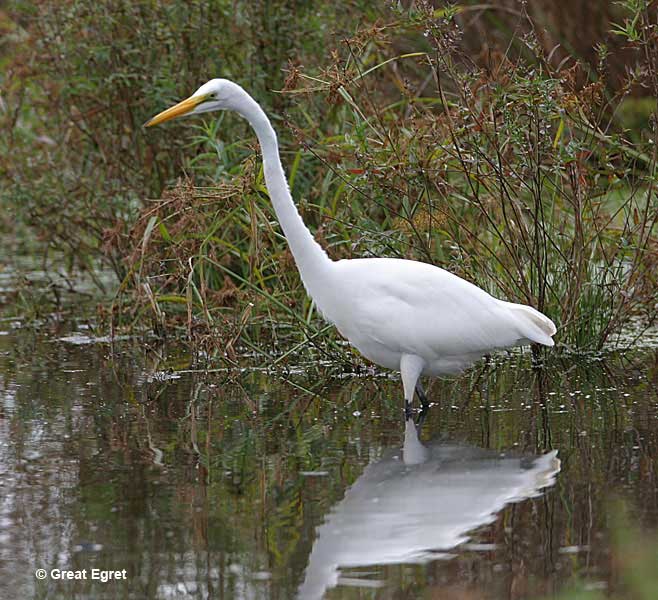
- Average size: 2 ft 7 in – 3 ft 5 in (80-104 cm)
- Average weight: 1.5-3.3 pounds (0.7-1.5 kg)
The Great Egret is a highly successful species dwelling in various temperate and tropical habitats across the world.
In North America, they’re most common in the Sun Belt of the United States and in Central and South America. These birds thrive near any form of water and are usually in wooded swamps and wetlands.
Great Egrets are known for their distinctive all-white plumage, with their tall, long legs, long S-curved necks, and dagger-like bills.
They’re excellent hunters, using a deadly jab with their bills to capture fish while standing immobile or slowly and carefully wading through wetlands.
Ibis, Spoonbills – Family Threskiornithidae
The Threskiornithidae family comprises 36 large wading bird species, traditionally classified into two subfamilies – ibises and spoonbills.
They range throughout the world and inhabit almost any area of fresh or brackish water, with some species also thriving in drier environments like landfills.
Roseate Spoonbill
Platalea ajaja
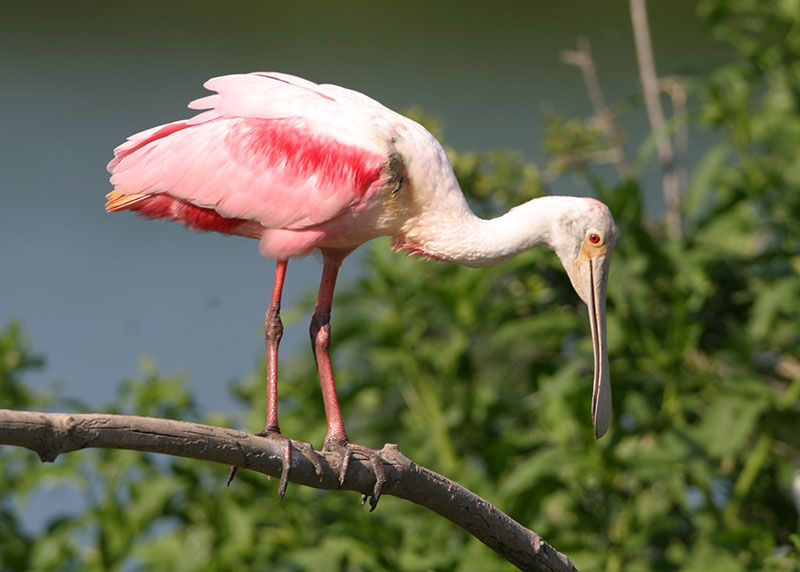
- Average size: 2 ft 4 in – 2 ft 1o in (71-86 cm)
- Average weight: 2.6-4 pounds (1.2-1.8 kg)
Roseate Spoonbills inhabit marshy areas, particularly mangrove swamps and mudflats from southern Georgia and Florida south through Central and South America (including Brazil, Bolivia, and Argentina). Their wings and underparts are light rose, their wing and tail coverts are deep carmine, and their upper neck and back are white. The pink and red pigments come from the food they eat.
These birds use their unique spoon-like bill to scoop up a variety of things from shallow water. They swish their bill back and forth in the water to collect minnows, small crustaceans, bits of plants, and insects.
Roseate Spoonbills typically forage in shallow, muddy water, and make a low, guttural sound while feeding. If they are not foraging, they may be roosting noisily in trees near mangroves, cypress, or willows.
Hawks, Kites, Eagles – Family Accipitridae
The Accipitridae is a diverse family of birds of prey that includes hawks, eagles, kites, harriers, and Old World vultures. They hunt a range of prey items from insects to medium-sized mammals.
Their striking plumage often consists of combinations of white, grey, buff, brown, and black.
Golden Eagle
Aquila chrysaetos
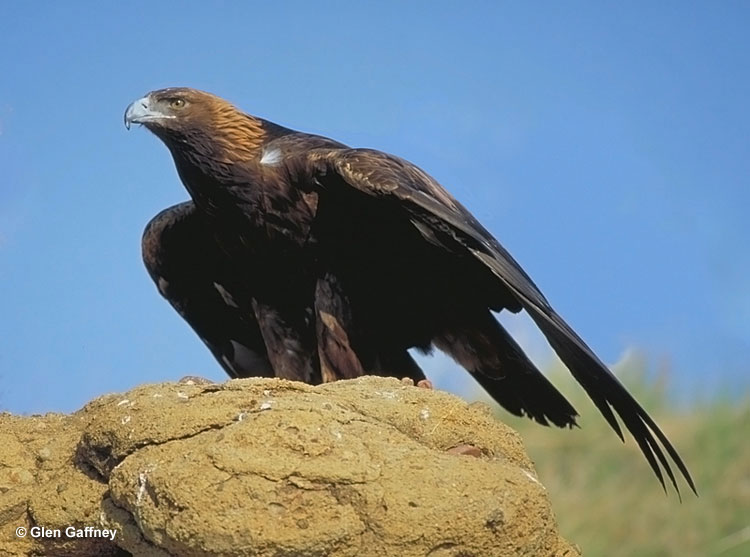
- Average size: 2 ft 2 in – 3 ft 4 in (66-102 cm)
- Average weight: 6.6-13 pounds (3-6 kg)
The Golden Eagle is a large and solitary bird of prey dwelling in open and semi-open terrain, most commonly in mountainous areas in the Northern Hemisphere. It is the most widely distributed species of eagle and can be recognized by its dark brown plumage with lighter golden-brown feathers on its nape.
As North America’s largest predatory bird, Golden Eagles use their impressive speed and agility, as well as their powerful feet and sharp talons, to hunt a variety of prey, including hares, rabbits, and marmots.
They maintain large home ranges or territories, which can be up to 77 square miles in size, and often mate for life.
For centuries, the golden eagle has been highly regarded in falconry and is revered in some ancient cultures for its hunting abilities.
Bald Eagle
Haliaeetus leucocephalus
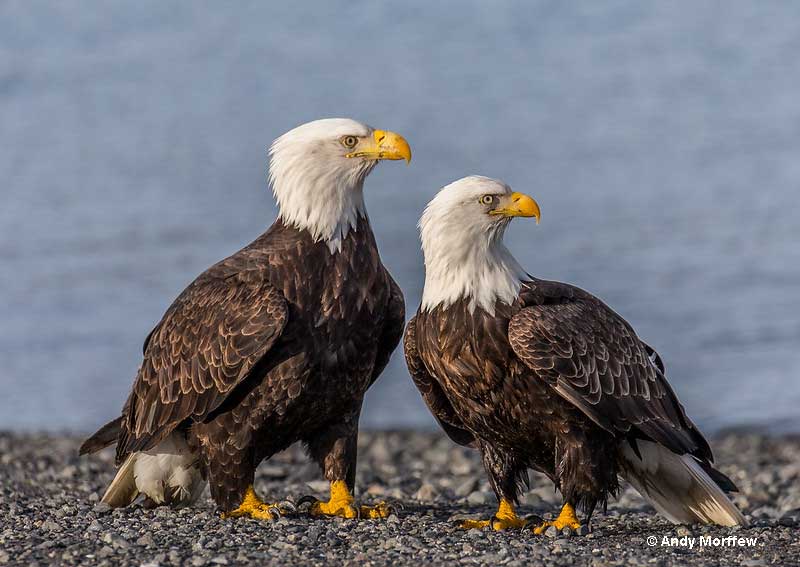
- Average size: 2 ft 4 in – 3 ft 4 in (70-102 cm)
- Average weight: 6.6-13.9 pounds (3-6.3 kg)
Bald Eagles, the national bird of the United States, can be found near large bodies of water throughout North America and tend to avoid human presence. They undergo four distinct stages of maturation, each taking one year.
You can recognize an adult Bald Eagle for its large size, yellow eyes and bills, white heads and tails, and dark brown bodies, which may appear black.
As the largest bird of prey on this list, they are known for their massive wingspan of 80 inches and their intimidating nature.
These raptors are opportunistic predators, sometimes scavenging and stealing food, sometimes hunting themselves. They often hunt by watching from high perches, then swooping down to catch their prey in their talons. Additionally, they can hunt by flying low, taking their prey by surprise.
Bald eagles are among the longest-lived birds, with a recorded age of 38 years.
Red-tailed Hawk
Buteo jamaicensis
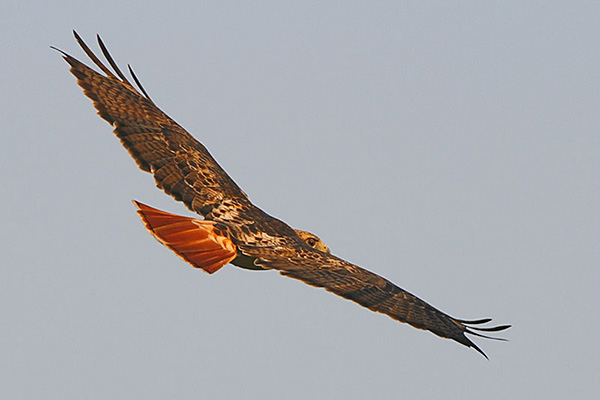
- Average size: 1 ft 6 in – 2 ft 2 in (45-65 cm)
- Average weight: 1.5-3.5 pounds (0.7-1.6 kg)
The Red-tailed Hawk, a bird of prey native to the Nearctic region, resides in a wide range of habitats and altitudes but typically prefer open areas with scattered elevated perches.
They come in 14 sub-species that vary from light auburn to deep brown, which include dark, light, and rufous morphs. Although both sexes appear alike, females are 25% larger than males.
These hawks mostly hunt by perching on high points and then swooping down to capture prey in their talons. Interestingly, the shrill cry used as a default sound effect for hawks and eagles in movies is often that of a red-tailed hawk, regardless of the species shown on screen.
Gulls, Terns, and Skimmers – Family Laridae
Members of the seabird family Laridae range throughout the world and consists of 100 species, including gulls, terns, skimmers, and kittiwakes. Their wide distribution is thought to be due to their great adaptability.
Herring Gull
Larus smithsonianus
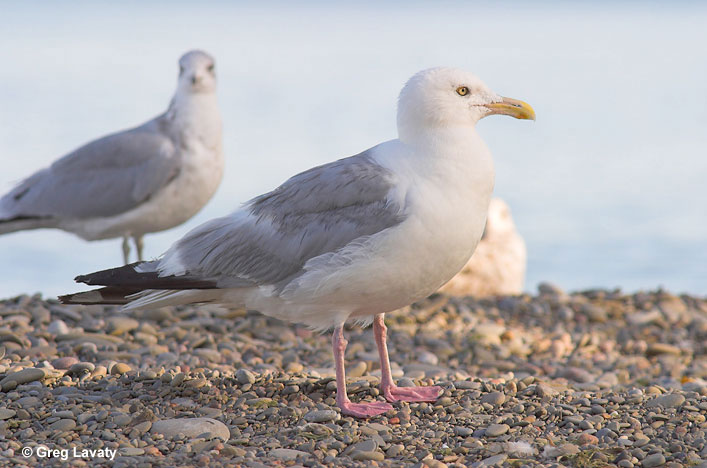
- Average size: 1 ft 10 in – 2 ft 2 in (56-66 cm)
- Average weight: 2.3-3.6 pounds (0.6-1.6 kg)
Herring Gulls, most often referred to as just seagulls, inhabit both North American coasts, although most commonly on the East Coast. While they reside year-round in the lower Great Lakes area, they primarily breed in the north and migrate to the south during winter.
They generally stick to coastal areas and choose it on the availability of nearby food sources, shelter from wind and the elements, and distance from predators.
The sexes look similar, with light-gray backs, black wingtips, and white heads and underparts. They scavenge along shorelines and around boats and have a unique ability to drink seawater thanks to special glands over their eyes. If you want to find one, search around large bodies of water.
Great Black-backed Gull
Larus marinus
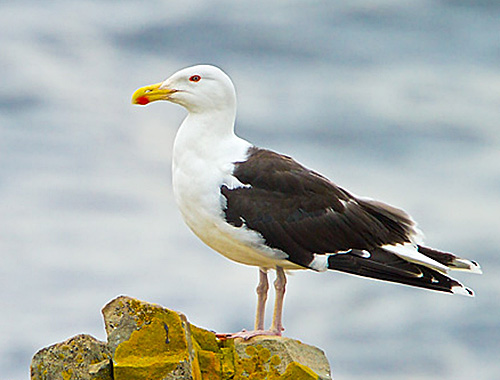
Photograph © Glenn Bartley.
- Average size: 2 ft 1 in – 2 ft 7 in (64-79 cm)
- Average weight: 1.7-5 pounds (0.75-2.3 kg)
The Great Black-backed Gull, the largest member of the gull family, is mainly found on the Atlantic Coast and ocean and occasionally inland around the Great Lakes.
Adults have a white head, neck, and underparts, dark grey wings and back, pink legs, and yellow bills.
They are aggressive hunters, pirates, and scavengers, known for breaking open hard-shelled mollusks and eggs by dropping them on rocks.
Great Black-backed Gulls commonly visit beaches or fishing piers and also scavenge on refuse around fishing boats, docks, and garbage dumps.
Owls – Family Strigidae
The Strigidae family, also known as true owls, consist of 230 living or recently extinct species that have a similar body plan despite greatly varying in size. They have large heads, short tails, round facial disks, and cryptic plumage.
They are mostly nocturnal and have specialized feathers and wing shape to fly silently, which helps them hunt without being heard by their prey.
Great Gray Owl
Strix nebulosa
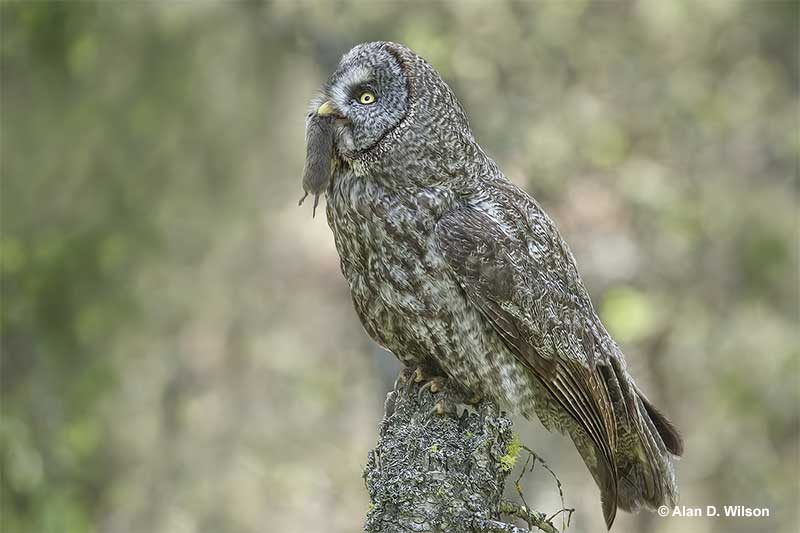
- Average size: 2 ft – 2 ft 9 in (61-84 cm)
- Average weight: 1.3-4.2 pounds (0.58-1.9 kg)
The Great Gray Owl is the world’s largest owl by length and is also known as the Phantom of the North.
These owls range throughout Alaska, Canada, the higher elevations of the Rocky Mountain States, northern Minnesota, and northern Wisconsin. These owls are common in Europe, too – mainly in Finland and Russia. They even have a noticeable range in Asia.
They prefer to inhabit coniferous forests in Canada and montane coniferous forests in the western States, usually pine and fir forests. In winter, they may inhabit other areas like fields, woodland edges, or tidal meadows.
The adult has a large, rounded head with a gray face, yellow eyes with dark circles, light underparts with dark streaks, and gray upperparts with pale bars. They primarily feed on small rodents such as voles and pocket gophers.
While hunting, they perch on a tree overlooking an open area and use their excellent hearing to locate prey. In winter, they silently glide and plunge into the snow to grab the prey with their sharp talons.
Frequently Asked Questions
What is the largest bird?
The largest and heaviest living bird in the world is the Common Ostrich.
What is the biggest flying bird?
The biggest flying bird in the world is the Andean Condor.
What is the largest bird in Europe?
The largest birds in Europe are the Common Crane and the Cinereous Vulture.
Read Next: Very Small | Small | Medium | BIGGEST BIRDS
